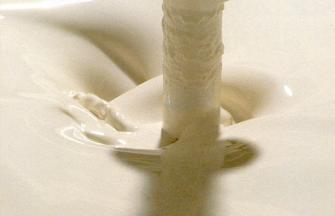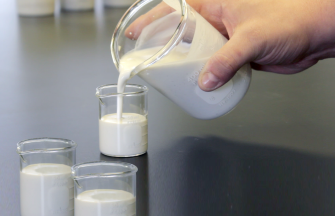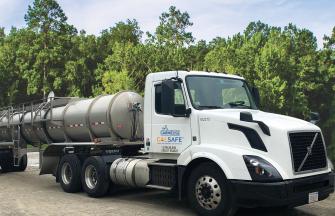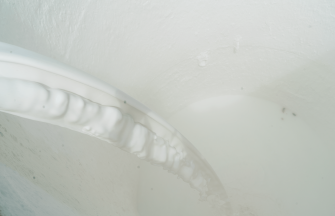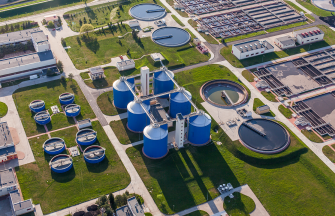
Slaked Lime: Product Description
Slaked lime is used in many industrial applications for a range of tasks. Most notably, slaked lime is used as an alkali (base) to raise pH levels. Hydrated lime also called slaked lime is produced when water is added to calcium oxide (CaO, or quicklime). The result of this mixing of water and calcium oxide (quicklime) is an exothermic reaction known as slaking. The slaking reaction produces calcium hydroxide, (Ca(OH)2). Initially, the calcium hydroxide is produced as a fine dry powder. With the further addition of water, a calcium hydroxide mixture typically called milk of lime, limewater or lime slurry is created. Ready-mixed slaked lime/hydrated lime slurry is commercially available in North America as Carmeuse CALSAFE® lime slurry.
Specifications Of CALSAFE Lime Slurry
Lime slurry/limewater/milk of lime solutions are specified according to the concentration of calcium hydroxide solids they contain by weight, which generally ranges from 18% to 40%.
In the US, CALSAFE lime slurry from Carmeuse can be obtained at two different concentrations, depending on where it is manufactured:
- CALSAFE 40% calcium hydroxide by weight solids is produced at the Carmeuse facilities in Baltimore, MD, and East Chicago, IL.
- CALSAFE 30% calcium hydroxide by weight solids is produced at the Carmeuse facility in Bellingham, MA.
In Canada, CALSAFE is produced at 25% calcium hydroxide by weight solids at the Carmeuse Blind River Operation in Ontario.
Operating Considerations
Storage
As a suspension of solids, slaked lime/hydrated lime slurry needs to be stored in a tank capable of continuously agitating the solution. Typically this solution storage is done with a vertical, single-shaft impeller. As the suspensions solubility is not perfect, we also recommend the tank be baffled to further promote adequate mixing. Mixing will prevent and reduce the amount of concentration of insoluble material in the calcium hydroxide.
For most applications, we recommend a calcium hydroxide storage tank capacity of no less than 7000 gallons: sufficient to take a complete 4500-4600 gallon load of CALSAFE without first running the tank to empty. However, the actual capacity required will be a function of various factors, including the amount of lime slurry used in your process, your distance from a CALSAFE distributor, how critical lime slurry is to your process, and the presence of any seasonal variation in demand.
Lime slurry is usually consumed before any degradation in quality occurs or the water in the mixture dissolves. That said, over time the calcium hydroxide particles will react with carbon dioxide (CO2) in the atmosphere to produce calcium carbonate lime (CaCO3). This adversely impacts the effectiveness of the slurry in whatever process or application it is being added to.
A final note on storage. Research shows that lime slurry will freeze at the same point as water, a temperature of 32∘F (0∘C). When CALSAFE is stored in areas prone to temperatures that drop below 32∘F, a heating element for the calcium hydroxide mixture is needed to keep the tank from freezing.
Cleaning
The use of lime slurry may result in the build-up of scale (often a white powder) on equipment used to handle and store it. This white powder caused by the calcium hydroxide mixture should periodically be removed to prevent damage and maintain operational efficiency. Pressurized water will handle any sign of scale for most cleaning applications. Weak acids and chemicals, such as citric acid or acetic acid, also provide effective cleaning media.
HSE Considerations
Compared to other alkalis, such as caustic soda, slaked lime slurry is a relatively benign material and is not considered a hazardous chemical for transportation purposes. However, some health, safety and environmental considerations are needed to mitigate any risk of harm in its production, handling and storage.
Health and Safety
Contact with slaked lime can irritate the skin and cause serious damage to eyes and other mucus membranes. Appropriate PPE, such as safety glasses with eye shields, and gloves, should be worn. We also recommend long-sleeve shirts to reduce the risk of direct contact with skin.
Although lime slurry should not cause chemical burns if it comes into contact with exposed skin (unlike caustic soda), it is important to wash it off immediately with plenty of water to avoid irritation. Any items of clothing that have become soaked with slurry should also be changed immediately.
Contact with eyes is more serious. It is important not to rub, but to flush with water for at least 15 minutes, pulling back the eyelid to make sure all particles of lime are washed out. Medical assistance should also be sought immediately.
Lime slurry spillages pose a slip hazard and should be cleaned up quickly to prevent slip and fall injuries (for more on the environmental impact of lime slurry spillages, see below).
More detailed health and safety information can be found on the CALSAFE Safety Data Sheet.
In operations that produce slaked lime onsite, heat generated by the slaking reaction and hot lime slurry pose a risk of thermal burns, unless adequate protective clothing is worn.
Finally, as a strong alkali (base), slaked lime will react violently with acids. Any process in which lime is added to an acidic environment should therefore be carefully controlled, ideally automated, to ensure the heat generated can be safely managed.
Although not flammable in itself, its capacity to produce significant heat on contact with acids means that areas used for handling and storing lime slurry should be kept free of flammable materials, to reduce the risk of fire in the event of a spill.
Environment
Compared to other strong alkalis, slaked lime slurry does not pose significant environmental risks. Small spills should be cleaned up quickly using plenty of fresh water, but do not pose a significant environmental hazard.
Going deeper on slaked lime slurry
Interested in finding out more about slaked lime slurry? Check out the following articles from our experts:
- Lime slaking 101
- Lime slurry handling: a good practice guide
- Considerations for a successful CALSAFE lime slurry trial
You can find out more about its use in specific industries here:
- Agriculture
- Chemicals manufacturing
- Civil Engineering & Construction
- Environment services
- Non-ferrous metals
For tailored advice on your specific application, you can also connect with us directly. Our experienced team is always on hand and happy to help you get the most out of your lime.

